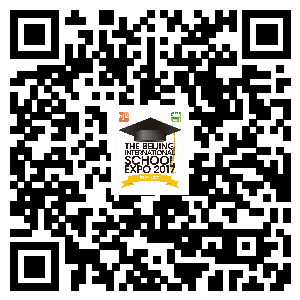[Editor’s Note: To meet schools featured in the School Choice Guide, register for the free Beijing International School Expo, where you can save time, energy, and money in you school comparisons. Scan the QR code below.]

What’s unique about the curriculum?
The hybrid curriculum is ever evolving and is offered from kindergarten to high school. In the case of China, students get the rigor of Chinese teaching, the inquiry-based and experiential pedagogies of the American tradition, and the emphasis on critical thinking, creativity, and intercultural fluency of the international curricula. Parents who are seeking a curriculum that dives deeper into Chinese language and culture while maintaining high standards of written and spoken English should look into schools who offer this curriculum.
How is it applied?
A hybrid system differs from institution to institution and country to country. The main driving force is collaboration between curriculum developers and teachers to think, plan, and execute the implementation of the program. A K-12 school will use the IPC for lower grades, IB for higher grades, and Chinese immersion at every grade that touches on culture, language, history, and other threads. Every unit and lesson planning is carefully crafted to have elements of both.
How well does this education system prepare students for the real world?
Graduates will possess the intellectual, cultural, and ecological fluency to navigate their preferred universities, cities, and professions due to the flexibility and versatility of the curriculum. A hybrid model can equip students to be ready to adapt to the ever-changing global landscape.
Where is it offered?
Based on the country (Chinese education system in China, Thailand education system in Thailand, etc) the hybrid system will use the best aspects of the local education system then couple with an internationally recognized education system. This system can be found all over the world, however each tailored to the local system. Parents are advised to ask the admissions offices for more information about the curriculum to get a clear view.

Curriculum spotlight: Molly Yun, British, has lived in England, Luxembourg, and now Beijing. Yun is a Grade 10 student at Keystone Academy.
What was the most interesting project you completed this year?
An interesting activity that I started at Keystone Academy is my Personal Project, a common activity in every IB school. My personal project is about sport psychology; it combines one of my passions and one of my recent interests. As a competitive golfer, I recently took more interest in the psychology behind the sport. Initially I was stuck for a personal project topic but then I realized I could combine two subjects I am really interested and excited about. I love sport and realized that looking into this could improve my mental game and my overall performance, which added even more to my curiosity.
What are the challenges?
I speak English and French fluently, and some Spanish, but I had never studied Mandarin until moving to Beijing in 2016 to attend Keystone Academy.
Like any school, there are a few challenges. However, attending Keystone has allowed me to learn and grow while experiencing a different culture. While this can be challenging, it is a great way to grow as a student and as a person. I experience many different cultures due to Keystone’s international community – staff and students.
An additional challenge I have encountered in this school is the different curriculum. In spite of my initial difficulties adapting to the different ways of grading and assessing, I have found the MYP program to be individual and fair. Each subject has four different criteria we are graded on that range from 0 to 8, 8 being the highest. We are not only assessed on our knowledge, but also on our general academic capabilities, like communication skills.
This curriculum can be described as the best of both worlds. It blends the Chinese education system (in the case of China based schools) with internationally recognized styles such as the International Baccalaureate (IB), the English National Curriculum (ENC), American Common Core Standards, and the International Primary Curriculum (IPC). The development of the curriculum is a customized model using the best practices from different types of approaches to create a unique program for the specific school. In China, this type of curriculum focuses on bilingualism and Chinese culture. Keystone Academy helped us understand this diverse curriculum.
This article originally appeared on page 12-13 of the 2017 issue of beijingkids School Choice Guide. Click here for your free online copy. To find out how you can obtain a hard copy, contact distribution@truerun.com.
Photo: Dave’s Studio




